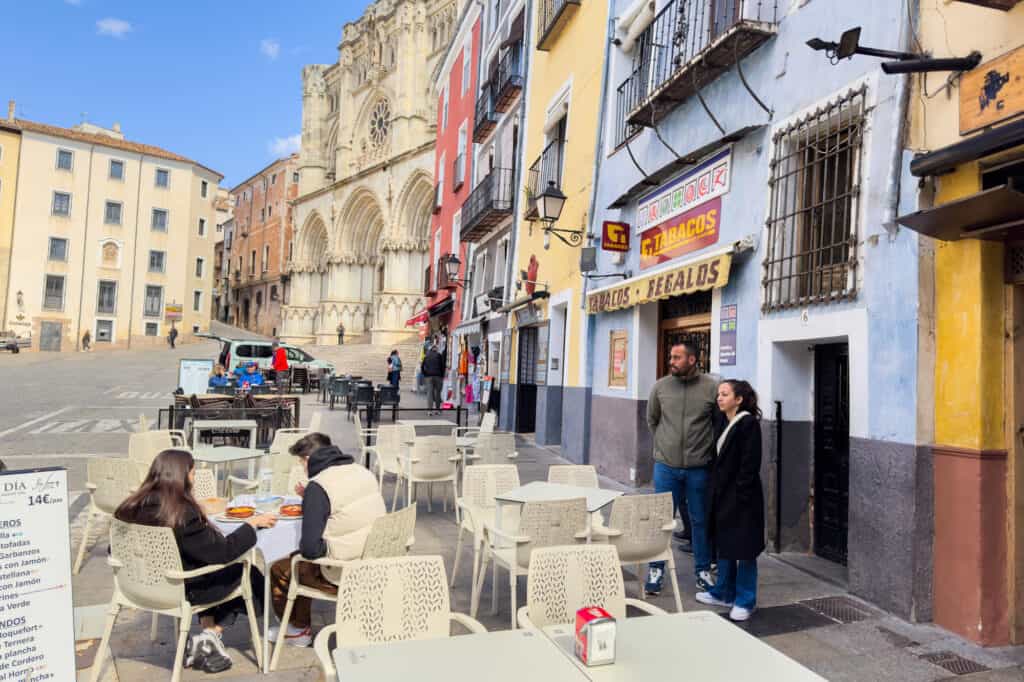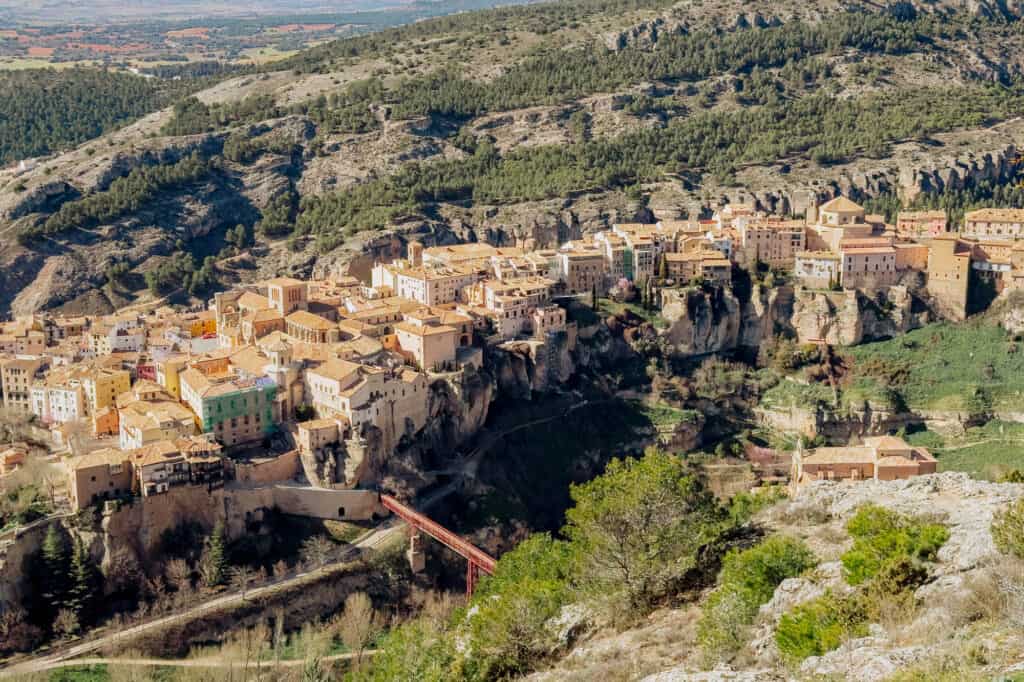Madrid to Cuenca: A Day Trip Itinerary
I love visiting small towns and cities around huge hubs, like Madrid. Cuenca is a great day trip or overnight trip, which is really easy to get to using the train system in Spain.
Cuenca’s small size and pedestrian-friendly streets make it easy to explore on foot. It’s known for a number of historic sites, including the famous “Hanging Houses” impossibly perched on rock cliffs.
Key Info on a Trip from Madrid to Cuenca:
- It’s a 70-minute train ride.
- The cost varies based on date/time, but starts at $15.
- You’ll need to take a bus or taxi from the train station into Cuenca’s Old Town.
Where to Stay in Cuenca
Cuenca’s close to Madrid, but it feels like a world away. If you’re looking to spend a night or two in a quieter town in Spain, consider checking out your options here. You can plug your dates into the interactive map below to check rates and availability.
The Train to Cuenca from Madrid
The drive from Madrid to Cuenca is about 105 miles. It’ll take about 2 hours.
I’d recommend the train for this one, unless a stop in Cuenca is part of a longer road trip through Spain.
Train Tickets to Cuenca
I’ve been using Trainline for my travel through Europe recently, and love how easy and efficient it is.
➡️ CLICK to Book Trains in Spain
On the website (or app) the search function easily brings up your options, times, and fares.
Once you choose your seats and purchase the tickets, you’ll get a QR code sent to you via text and email. You show that at the station when you go to board.
Trainline eliminates having to use the kiosks in the station and having to keep track of a paper ticket.
Taking the Train to Cuenca
From the Chamartin Station in Madrid, Cuenca is about a one-hour trip.
There are departures every hour, or every two hours.
Cost of the Train to Cuenca
While the cost of the fare will vary, based on date and time, you can expect to pay about $15 each way from Madrid to Cuenca.
Some trains will cost as much as $60.
To be safe, I’d book at least a day in advance (especially during peak tourist seasons) to ensure a seat on your preferred departure from Madrid.
Arriving in Cuenca
Cuenca has a nice, modern train station, but it’s not overly convenient to the town itself.
You have two options: the bus or a taxi. I’ve done both, and either is easy enough and cost-effective.
If you choose the bus, bring cash. It’ll be a few Euros for the ride into Cuenca from the train station.
Look for Bus 1 or L1. It makes a loop, leaving the station every 30-minutes.
Alternatively, there’s almost always a taxi available outside the train station that’ll take you into Cuenca.
Sites to See in Cuenca
Cuenca’s historic center is a UNESCO World Heritage Site, with narrow cobbled streets, ancient churches, and picturesque squares.
It’s all very walkable and tourist-friendly
Walking Through Cuenca
Cuenca’s pedestrian-friendly streets make it easy for visitors to explore on foot.
You can wander past ancient churches, admire the iconic “Hanging Houses” perched on the cliffside, and stroll along the picturesque river gorge below.
A walk through Cuenca will lead you to small shops and local cafes, serving up traditional Castilian cuisine.
If you’ve taken the bus into Cuenca, it’ll drop you off at the Plaza Mayor.
Plaza Mayor
You can begin your visit at the Plaza Mayor, home to the Cathedral of Cuenca.
Today, the Plaza Mayor serves as a gathering place for locals and tourists alike. You’ll find a mix of both at the outdoor cafes.
The homes may have been built so the cliffs could act as natural barriers against invaders, or by wealthy merchants looking to maximize their homes by adding space over the gorge.
Either way, in modern times, the “Hanging Houses” of Cuenca are a main draw for tourists from all over the world. Many have been converted into restaurants, galleries, and museums.
Mirador Cerro Socorro
The Mirador Cerro Socorro is a statue of Jesus Christ, situated atop a hill on the outskirts of Cuenca, overlooking the river gorge.
It’s a hike to the viewpoint by foot. You can also drive up to get the panoramic views of Cuenca.
The hike up, along a well-marked rocky path, is about a mile long. It’s steep in spots, so it’ll take a good 30-minutes.
It’s a very pretty trail, lined with rock walls and lush greens.
Madrid to Cuenca Day Trip Itinerary
I’ll lay out a day trip itinerary to Cenca in basic terms here.
- 9:00am – Depart Madrid
- 10:00am – Arrive at Cuenca Train Station
- 10:30am – Arrive in Old Town (Plaza Mayor)
- After coffee at a cafe, explore the cathedral.
- Behind the cathedral, you’ll find the “Hanging Houses.”
- Cross the bridge, and walk up to the Mirador Cerro Socorro.
- Walk back to town and up the main street past the cathedral. You’ll come to a series of restaurants with great views over the city.
- After eating, walk back down into town and head to the Plaza de Mangana.
- As you wait for the bus back to the train station, enjoy a glass or carafe of wine in the Plaza Mayor.
Best Time to Visit Cuenca
The weather in central and southern Spain is relatively mild year-round. Even in winter, if the sun is shining, a day trip to Cuenca is a good idea.
Here are the average daily high and low temperatures in Cuenca, by month:
- January: High 46°F, Low 32°F
- February: High 50°F, Low 34°F
- March: High 56°F, Low 38°F
- April: High 61°F, Low 42°F
- May: High 68°F, Low 48°F
- June: High 75°F, Low 55°F
- July: High 82°F, Low 61°F
- August: High 82°F, Low 61°F
- September: High 75°F, Low 55°F
- October: High 66°F, Low 48°F
- November: High 54°F, Low 39°F
- December: High 48°F, Low 34°F
In the summer, when other parts of Spain are stiflingly hot, Cuenca is still enjoyable.
FAQs About a Madrid to Cuenca Trip
Let’s go over a few more frequently-asked-questions about a trip to Cuenca. Many of these were already answered above.
How far is Cuenca from Madrid?
The drive from Madrid to Cuenca is about 105 miles. It’ll take about 2-hours.
To get there faster, take the train which will take about one hour.
How much does the train to Cuenca from Madrid cost?
The train fares vary, but can be as low as about $15 each way from Madrid to Cuenca.
What is Cuenca known for?
Primarily, Cuenca is famous for its “Hanging Houses,” homes built on rock cliffs over a river gorge. It’s also home to a massive cathedral and charming cobblestone streets lined with shops and cafes.
Wrap: Is a Day Trip to Cuenca Worth It?
I’d pass on a rainy day, but if the weather cooperates, Cuenca is definitely worth a day trip from Madrid.
The trains make it so easy. They’re fast and comfortable, and there are multiple departure (and return) options.
I love getting out of the big hub cities, like Madrid, to explore smaller towns like Cuenca.
For one the only minor hassle is getting from the train station to the Old Town. Just be aware of the extra step heading into your day trip and you’ll be all set to enjoy the streets and sites of Cuenca!

















